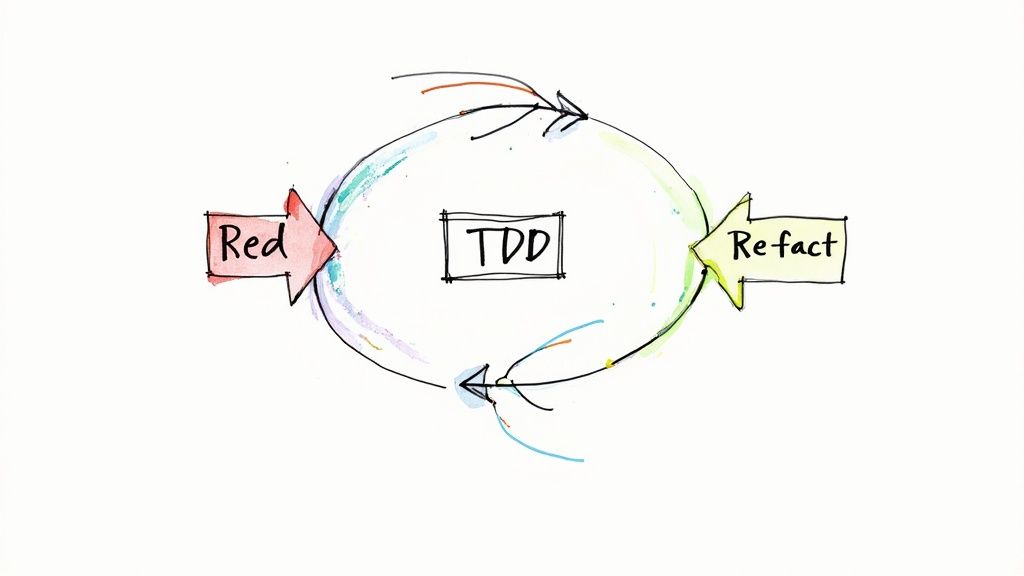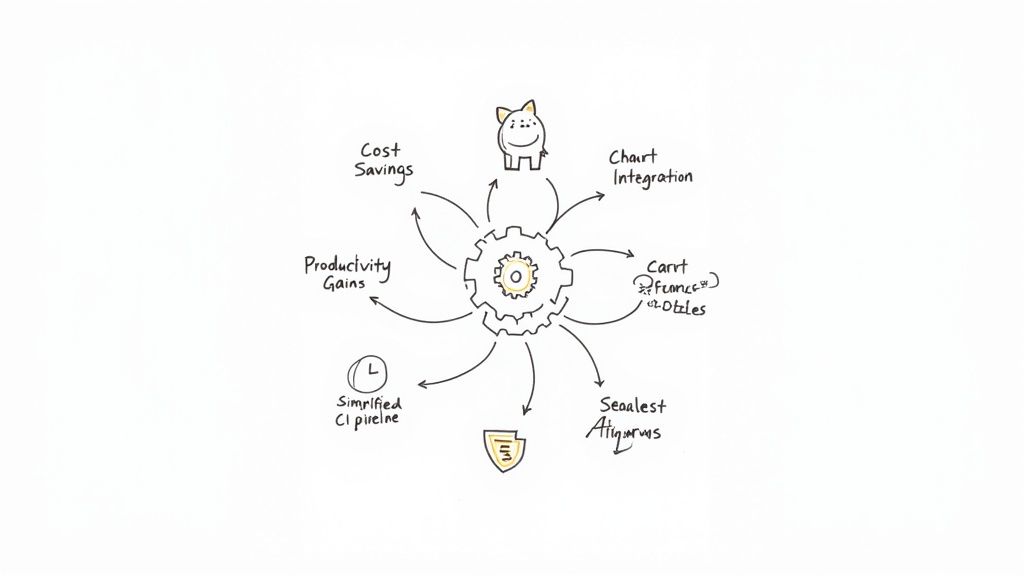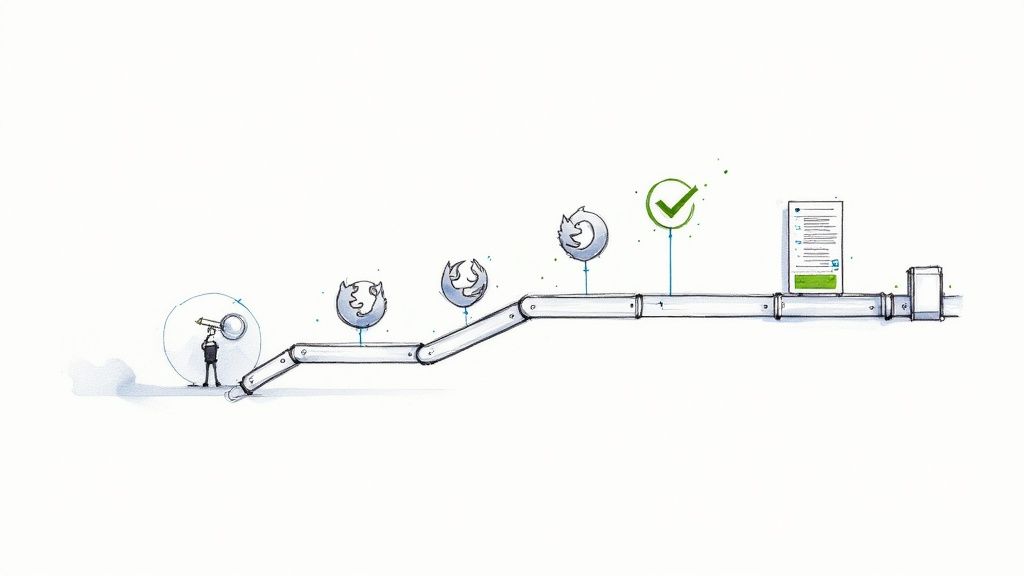The Complete Definition of Test Driven Development: A Proven Guide for Modern Development Teams

The Evolution and Impact of Test Driven Development

Test-Driven Development (TDD) has changed how software teams build applications, but its path to widespread adoption tells an interesting story. What was once seen as an unusual approach - writing tests before code - is now standard practice for many development teams. Let's explore how TDD emerged and why it matters for building better software.
In the early days of software development, testing typically happened after coding was complete. This led to many headaches: bugs found late in the process were expensive to fix and often caused project delays. The roots of TDD trace back to the late 1990s when Kent Beck, while working on Extreme Programming, developed a more structured approach. Beck's ideas weren't entirely new - NASA's Project Mercury had used similar "test-first" concepts years earlier to speed up development. But Beck refined these concepts into the TDD practice we know today. Learn more about the history of TDD
From Extreme Programming to Mainstream Adoption
TDD grew alongside other key practices like pair programming and continuous integration as part of the Extreme Programming (XP) movement. At first, many developers thought writing tests before code seemed backward. But teams who tried it discovered something surprising - it helped them write better code from the start and catch problems early.
The Impact of TDD on Development Teams
TDD is much more than a testing method - it's a powerful way to design software. When developers write tests first, they have to think carefully about how their code will work and what it needs to do. Take building a user login system: writing tests first makes you consider important cases like handling wrong passwords or duplicate usernames before writing any actual code. This leads to more reliable features and fewer surprises later.
Why TDD Remains Crucial for Modern Development
Software teams face constant pressure to ship new features quickly while maintaining high quality. TDD helps address both needs by catching bugs early and making code easier to change over time. Teams that practice TDD consistently report:
- Fewer critical bugs in production
- More confidence when making changes
- Better designed, more maintainable code
- Clearer documentation through tests
These benefits make TDD especially valuable as projects grow more complex. The practice continues to help teams deliver reliable software that can adapt to changing needs.
Mastering the Core Principles of TDD

Getting started with test-driven development (TDD) means learning more than just writing tests before code. The heart of TDD lies in the Red-Green-Refactor cycle - a practical method that helps developers write clean, maintainable code. This simple but powerful approach starts by writing a failing test, making it pass with basic code, then improving that code's quality. Following these steps consistently helps build reliable software while keeping the codebase clean and simple.
The Red-Green-Refactor Cycle
- Red Phase: Write a test for your new feature. The test will fail at first since you haven't built the feature yet.
- Green Phase: Write the simplest code possible to make your test pass. Focus on getting it working first.
- Refactor Phase: Clean up your code while keeping the tests green. Remove duplication and improve readability.
This step-by-step process helps break down complex problems into smaller, manageable pieces. It fits naturally with Agile development by adding quality checks throughout the coding process, not just at the end.
The Design Impact of TDD
TDD shapes how we structure our code from the ground up. By thinking about tests first, developers naturally create modular and decoupled code that's easier to test and maintain. Take a user login system - with TDD, you'll naturally separate password checks, session handling, and error messages into clear, testable pieces that work well together but can also stand alone.
Key Benefits of TDD
Teams that use TDD effectively see several concrete improvements:
- Enhanced Code Quality: Regular test feedback catches bugs early and often
- Improved Maintainability: Clean, modular code makes changes simpler
- Faster Debugging: Finding and fixing issues becomes quicker and cheaper
TDD began in 1999 as part of Extreme Programming, developed by Kent Beck. It changed how developers think about testing - instead of an afterthought, testing became a key part of the design process. Today, it helps teams write better code with fewer surprises Learn more about TDD.
Many successful development teams now see TDD as a design tool first and a testing method second. This mindset shift helps them build software that's both solid today and ready for tomorrow's changes, similar to how Mergify helps teams manage their code integration smoothly and safely.
Measuring Real-World TDD Success Stories

Let's examine how companies track and measure the concrete results of implementing Test-Driven Development (TDD). By looking at specific metrics and real outcomes, we can understand exactly how TDD impacts both code quality and business results. This means going beyond simply writing tests to carefully monitoring how they shape the development process.
Quantifying the Impact of TDD
Teams use several key metrics to evaluate their TDD implementation:
- Defect density: Measures bugs per lines of code - lower numbers mean better code quality
- Cycle time: How long it takes to complete development tasks from start to finish
- Code coverage: The percentage of code protected by tests, focusing on critical paths
The numbers tell a compelling story. Projects using TDD see 40-80% fewer defects compared to those without it. Teams also report roughly 20% less time spent debugging issues. These improvements come from catching problems early through consistent testing. Learn more about TDD statistics and success metrics.
To calculate TDD's return on investment (ROI), teams compare implementation costs against savings from:
- Reduced bug fixing time
- Lower maintenance needs
- Faster development cycles
- Fewer production issues
TDD's Influence Beyond Code
TDD's benefits extend past technical metrics into team dynamics and project success. Developers report feeling more confident making changes when backed by comprehensive tests. This creates a positive feedback loop - better testing leads to smoother development, which encourages even more testing.
The improved confidence shows in how teams work together. Communication becomes clearer, iterations happen faster, and teams can adapt more easily to new requirements. With a solid foundation of tested code, developers spend less time worried about breaking things and more time delivering value. Like other tools that improve collaboration, TDD helps create an environment where teams can focus on building great software.
Test Driven Development (TDD) Implementation section in human-written style:
Building Your TDD Implementation Strategy

Making Test Driven Development (TDD) work for your team starts with picking the right tools. The testing framework you choose sets the foundation - popular options like JUnit for Java and PyTest for Python make it easier to write and run tests. These frameworks fit naturally into most development environments and support many different testing needs.
Setting Up Clear Testing Patterns
Good tests follow a clear pattern. The Arrange-Act-Assert approach breaks testing into three simple steps that anyone can follow:
- Arrange: Get your test data and environment ready
- Act: Run the code you want to test
- Assert: Check if you got the results you expected
When everyone follows this pattern, tests become easier to understand and maintain over time.
Adding TDD to Existing Projects
Starting TDD with legacy code can feel overwhelming at first. The key is to begin small - pick parts of the code that break often or cause the most problems. Add tests there first, then gradually expand to other areas. This lets your team practice TDD without disrupting their current work.
Making Tests Easy to Maintain
Write tests that focus on one thing at a time. Small, focused tests make it easier to find and fix problems when they come up. Instead of creating huge tests that check many things at once, write several smaller tests. This keeps your test suite manageable as it grows.
Growing TDD Across Teams
To make TDD successful across your organization, you need support at every level. Start with one or two teams to show what's possible. Track improvements in code quality and fewer bugs. When other teams see these success stories, they'll want to try TDD too. The first teams can help teach others, spreading good testing practices naturally.
Test Driven Development gives teams a solid way to build better software. When done right, it leads to more reliable code and faster development - similar to how Mergify helps teams work more efficiently. With some planning and patience, your team can make TDD a natural part of how they work.
Overcoming Common TDD Implementation Challenges
Many teams struggle when adopting Test-Driven Development (TDD), particularly when transitioning from their existing practices. Common issues include team resistance, misunderstandings about TDD practices, time constraints, and general hesitation around change. Here's how to tackle these key challenges.
Managing Time Pressures and Deadlines
Many developers worry that TDD will slow them down. Yes, writing tests first takes extra time upfront, but it pays off by catching issues early and reducing debugging time later. Think of it like cooking with mise en place - spending time to prep ingredients first makes the actual cooking smoother and prevents mistakes. Start small by applying TDD to bug-prone features first. This focused approach helps teams see concrete benefits without feeling overwhelmed.
Maintaining Test Suite Health
Test suites naturally grow as projects expand. Without regular maintenance, tests can become messy and slow, turning from helpful tools into development roadblocks. Treat your test code with as much care as your production code - clean it up regularly, remove duplicates, and keep it readable. Just as Mergify helps streamline code merging, good test organization practices keep your test suite running smoothly.
Handling Complex Dependencies
When code relies heavily on external systems or components, testing becomes tricky. Mocks offer a practical solution here. They let you simulate how dependencies behave, giving you control over test conditions. Say your code talks to a payment processor - mocking lets you test payment flows without hitting real payment APIs. This approach makes tests faster and more reliable by focusing on just the code you're testing.
Keeping the Team Motivated
Moving to TDD requires a shift in how teams think about development. Success depends on getting everyone on board. Share specific examples of how TDD has helped - like catching a tricky bug early or making a feature change easier. Real success stories convince skeptics better than theoretical benefits. Create space for the team to learn and experiment with TDD together. When people feel supported in trying new approaches, they're more likely to stick with them.
Future-Proofing Your TDD Practice
Test-Driven Development (TDD) sits at the heart of quality software development. As software architectures become more complex, adapting your TDD approach helps keep your codebase dependable and maintainable. Let's look at how successful teams are making their TDD practices work in modern software development.
Adapting TDD to Microservices
When working with microservices, testing becomes more challenging. Each service change can affect others, making comprehensive testing crucial. TDD helps catch these potential issues early.
Here's how to strengthen your microservices testing:
- Contract testing: Test how services communicate with each other to prevent unexpected breaks
- Consumer-driven contracts: Build tests based on how services actually use each other
- Service isolation: Test each service independently using mocks for faster, more reliable results
Consider a user authentication service - contract tests help ensure that changes don't break dependent services that need user data. This keeps your distributed system stable and reliable.
TDD and AI-Driven Development
As teams add AI features to their applications, TDD practices need adjustment to handle AI's variable outputs.
Key approaches for testing AI components:
- Test behavior patterns: Focus on validating acceptable ranges of outputs rather than exact matches
- Smart input selection: Test representative samples of different input types
- Key metrics tracking: Monitor accuracy and other performance indicators to catch AI model issues early
Testing AI systems means shifting from exact output matching to validating that results stay within acceptable boundaries.
Evolving Your TDD Strategies
Keep your TDD practice effective with these core habits:
- Clean up test suites: Remove duplicate tests and update others as features change
- Try new testing tools: Pick up useful new testing approaches and tools as they emerge
- Share knowledge: Build team expertise through regular discussion of testing practices
Following these guidelines helps teams deliver quality software through thoughtful, practical TDD practices. This approach keeps working even as development needs change.
Ready to make your development process more efficient? See how Mergify can help your team succeed





